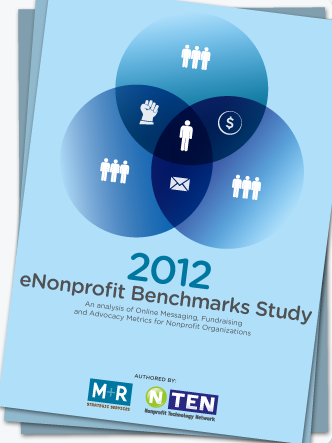Note: This post refers to an archived publication! Visit www.e-benchmarksstudy.com for the most recent versions of all our Benchmarks Studies.
The following is a guest post from our friend Karla Capers, who runs the online program at the Union of Concerned Scientists. She offered to give us a peek into how she uses the eNonprofit Benchmarks Study in her daily life. Enjoy.
I should probably admit up front that I’m kind of a data junkie. It’s got nothing to do with actually liking math or knowing tons of Excel tricks. I love data and metrics and benchmarks because they make my job easier – and they make me look smart and strategic.
Whether I’m trying to determine the best strategy for an online advocacy campaign or our next series of fundraising appeals, they tell me what’s working, what’s not, and where we need to focus our efforts. I do what the numbers tell me to do.
Case in point: Ever sit down at the beginning of your fiscal year with a blank sheet of paper and the charge to write your annual plan? (I know, no one uses paper anymore…) You sit there, thinking about all the tests you want to run and tools you want to try out… but then you look at the budget and staff time you have to allocate, and you quickly realize there’s no way you can do everything you want to do!
That’s where the eNonprofit Benchmarks Study comes in handy. Every year, I track our basic metrics against prior years so I can see how our program is doing over time. Then, I add in the Benchmarks stats so I can see how we’re tracking compared to our peers, year over year. Are we going up in places where other organizations are declining? Or vice versa?
Those inflection points make it pretty clear where my program is strong, where we could improve, and how much improvement we could realistically expect to see. Prioritization done! Then I can easily write up a plan based on the top three or four items I think we need to focus on in the coming year and not waste time on areas where our program is already strong.
Small potatoes? Okay, here’s another example where Benchmarks helped me remake our entire online program.
A few years back, I was looking at our metrics with the eNonprofit Benchmarks overlay, and I started to notice that all our basic email metrics–open rates, click rates, response rates–were falling. No biggie; everyone’s rates were falling. But what alarmed me is that our metrics were falling at a faster rate than the Benchmarks Study said our peers rates were falling (ack!). If we kept going at this rate, within two years we’d be below average across the board. And no one wants to be below average!
This wasn’t just an isolated metric where our program was underperforming. This was a sign that our supporters were losing interest.
I took it as an opportunity to reassess our entire online program. We pulled together a cross-department team of folks who rewrote the goals for our online communications. Then, based on those goals, we specified what types of emails we would send out–and what we wouldn’t. We set a limit to the number of emails supporters could receive from us each week. We clarified how email messages would be prioritized against each other and who in the organization had final say if we had more emails scheduled than we could actually send. And we created guidelines for staff about how to conceive of and write compelling emails that would get opened, read, and result in meaningful actions or donations to help the organization reach its goals.
The Benchmarks data helped staff at all levels understand why we needed to change. It was a hugely time-consuming process, to be honest, but the results have been great. And I’m happy to say that today we’re above average on most of our metrics. And where we’re not–well, that’s in my work plan for next year!


